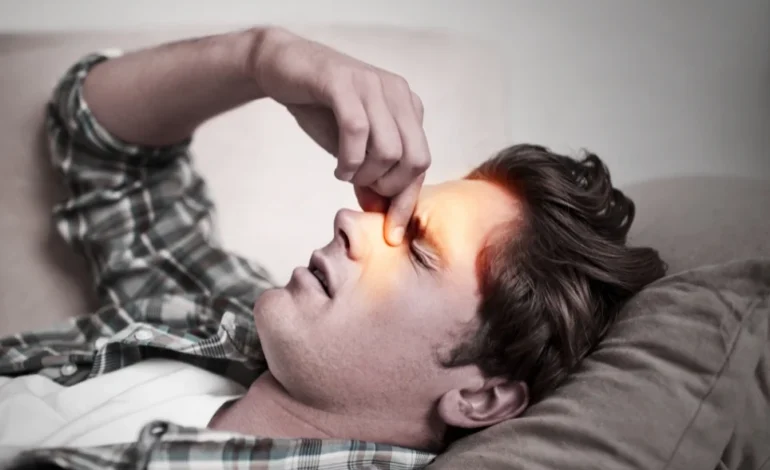
Banish Sinusitis Agony: Unlock Your Guide to Sinus Freedom Now!
Are You Battling the Silent Scourge of Sinusitis?
Sinusitis, also known as a sinus infection, refers to the inflammation of the sinus cavities within the facial and skull bones. It’s a prevalent medical condition that can arise from diverse causes, triggering a spectrum of symptoms that impact an individual’s daily life. The condition involves the swelling or irritation of the air-filled sinus spaces due to infections or other contributing factors, leading to discomfort and potential complications. Symptoms may include nasal congestion, facial pressure, headache, and a decreased sense of smell, affecting an individual’s overall well-being. Understanding the root causes and manifestations of sinusitis is crucial for accurate diagnosis and effective treatment to mitigate its impact on daily life.
Sinusitis, Or Sinus Infections, Can Develop Due To Various Causes:
1. Viral Infections: Often, sinusitis is initiated by common viruses, such as those responsible for the common cold. These viruses lead to inflammation of the sinus lining, hindering proper drainage and causing the accumulation of mucus and blockages within the sinuses.
2. Bacterial Infections: Following a viral upper respiratory infection or due to other factors, a bacterial infection might develop in the sinuses. The presence of bacteria can cause more severe and prolonged symptoms, often necessitating antibiotics for treatment.
3. Allergies: Allergic reactions to airborne particles can trigger allergic or allergic fungal sinusitis. In these cases, the sinuses become inflamed due to an allergic response, further complicating sinus drainage and causing congestion and discomfort.
4. Anatomical Abnormalities: Structural issues within the nasal passages or sinuses, such as a deviated septum, nasal bone spurs, or narrow sinus openings, can obstruct the normal flow of mucus and airflow, leading to recurring sinus infections.
5. Nasal Polyps: Noncancerous growths within the nasal and sinus passages can obstruct normal sinus drainage. These polyps can form as a result of chronic inflammation and can increase the risk of sinus infections due to impaired drainage.
6. Immunodeficiency: Weakened immune systems, which can result from conditions like HIV/AIDS or immune-suppressing medications, may increase the vulnerability to sinus infections.
7. Environmental Factors: Exposure to environmental pollutants, smoke, or certain chemicals can irritate the sinus lining, leading to inflammation and potential infection.
Understanding these causes is crucial in diagnosing and managing sinusitis effectively, as treatment approaches may vary depending on the underlying cause.
Symptoms of Sinusitis
1. Nasal Congestion and Discharge: The inflammation of sinus membranes causes blockages or increased mucus production, resulting in a congested or runny nose.
2. Facial Pain or Pressure: Inflamed sinuses can lead to a feeling of pressure or pain in various areas of the face, commonly around the eyes, forehead, or cheeks. This discomfort may intensify when leaning forward or lying down.
3. Cough: Postnasal drip, wherein mucus travels down the throat, can prompt coughing.
4. Reduced Sense of Smell: Swelling and congestion within the sinuses can impair the ability to smell or result in a complete loss of the sense of smell.
5. Headache: The congestion and pressure in the sinus cavities often cause headaches, particularly around the frontal area or behind the eyes.
6. Fatigue: Sleep disturbances due to nasal congestion or breathing difficulties can lead to tiredness and general fatigue.
7. Sore Throat: The drip of mucus down the throat might lead to irritation, causing a sore throat.
8. Bad Breath: Foul-smelling breath can result from stagnant mucus and postnasal drip.
9. Fever: In bacterial sinusitis, a low-grade fever might be present, although it’s not as common in cases primarily caused by viruses or allergies.
These symptoms can manifest differently based on the individual, the type of sinusitis (acute or chronic), and the underlying cause. Understanding these symptoms aids in proper diagnosis and targeted treatment to alleviate discomfort and prevent complications.
In Diagnosing Sinusitis, Healthcare Providers Typically Conduct Various Examinations And Tests:
1. Clinical Assessment: An evaluation involving the patient’s medical history and a thorough assessment of the physical symptoms related to sinusitis.
2. Nasal Endoscopy: This involves the insertion of a thin, flexible tube with a tiny camera into the nasal passages, enabling a visual examination of the sinuses to detect signs of inflammation or structural abnormalities.
3. Imaging Studies: CT (Computed Tomography) or MRI (Magnetic Resonance Imaging) scans are utilized to provide detailed images of the sinuses. These imaging tests aid in identifying any structural issues, blockages, or abnormalities within the sinus cavities.
4. Nasal Culture: A swab of nasal secretions is obtained to identify the specific pathogen causing the infection. This test can help determine if the infection is caused by bacteria, aiding in the selection of appropriate antibiotic treatment.
5. Allergy Testing: In cases of suspected allergic sinusitis, allergy tests may be conducted to identify specific allergens that trigger the inflammatory response in the sinuses, helping to guide appropriate management strategies.
Certainly, Treatments For Sinusitis :
1. Antibiotics: Effective for bacterial sinusitis, antibiotics combat bacterial infections. Prescribed based on the severity and type of the infection, these medications work to eradicate the underlying infection causing sinusitis.
2. Nasal Decongestants: Nasal sprays or drops containing decongestants help shrink swollen nasal tissues, reducing congestion and facilitating easier breathing by opening nasal passages.
3. Corticosteroids: These medications, available in nasal sprays or oral forms, reduce inflammation in the nasal passages and sinuses. By alleviating swelling and congestion, corticosteroids aid in managing symptoms.
4. Saline Nasal Irrigation: Rinsing the nasal passages with a saline solution helps clear mucus and irritants, offering relief from congestion and aiding in the removal of infectious agents, promoting better sinus health.
5. Allergy Management: Addressing allergic sinusitis involves identifying and avoiding allergens that trigger the sinus inflammation. Additionally, the use of allergy medications or immunotherapy can effectively manage allergic symptoms.
6. Balloon Sinuplasty Surgery: A minimally invasive procedure involving the insertion of a small balloon into the sinuses, inflated to widen narrowed sinus passages. This technique enhances drainage and ventilation, reducing the recurrence of symptoms in chronic cases. Post-balloon sinuplasty surgery, there is little to no downtime afterward.
7. Other Surgical Interventions: Procedures like endoscopic sinus surgery aim to address structural issues within the sinuses. These techniques help to correct anatomical abnormalities, improve drainage, and decrease the frequency of symptoms in chronic cases.
The variety of treatment options available for sinusitis ensures a tailored approach, addressing symptoms and underlying causes to effectively manage the condition, ranging from conservative measures to advanced surgical interventions.
Outlook (Prognosis)
The outlook for sinusitis is generally favorable, with many cases responding well to appropriate treatment. Here’s an overview of the prognosis for different forms of sinusitis:
1. Acute Sinusitis:
In most cases, acute sinusitis can resolve within a few weeks with proper treatment, which often includes antibiotics, decongestants, and symptomatic relief measures. The majority of individuals recover completely from acute sinusitis without any long-term complications.
2. Chronic Sinusitis:
Chronic cases of sinusitis might necessitate ongoing management, but the prognosis remains positive. Treatment for chronic sinusitis might include more aggressive measures such as longer antibiotic courses, corticosteroid nasal sprays, and, in some cases, surgical interventions like Balloon Sinuplasty or endoscopic sinus surgery to improve sinus drainage. With appropriate management, many individuals with chronic sinusitis can experience significant relief from their symptoms and a reduction in the frequency and severity of recurrences.
Timely and appropriate treatment significantly influences the prognosis for both acute and chronic sinusitis, ensuring effective symptom management and reducing the risk of complications. Regular follow-ups with healthcare providers allow for monitoring and adjustments to the treatment plan, thereby improving the overall prognosis for individuals suffering from sinusitis.
Worried About Possible Complications?
Sinusitis, if left untreated or managed inadequately, can lead to potential complications, although these occurrences are relatively uncommon. Complications may include:
1. Chronic Inflammation: Prolonged or recurrent sinusitis that remains untreated can result in persistent inflammation in the sinus cavities, contributing to ongoing discomfort and recurring infections.
2. Orbital or Periorbital Cellulitis: In severe cases, particularly with untreated severe infections, the infection might extend to the eye area, leading to swelling and inflammation of the tissues around the eye (periorbital) or within the eye socket (orbital cellulitis).
3. Meningitis: Although extremely rare, severe sinus infections, if left untreated, can potentially lead to meningitis. This condition involves the inflammation of the protective membranes covering the brain and spinal cord.
4. Brain Abscess: Infections that are left uncontrolled or inadequately treated can exceptionally spread to the brain, resulting in a brain abscess. This rare but serious complication involves a collection of pus in the brain tissue.
Timely and appropriate medical intervention, along with effective treatment of sinusitis, significantly reduces the risk of these complications. It’s crucial to seek medical attention for persistent or severe symptoms to prevent the progression of sinusitis and minimize the potential for complications.
Seeking Medical Attention Is Recommended Under The Following Circumstances:
1. Persistent Symptoms: If symptoms of sinusitis persist despite over-the-counter remedies or if they worsen over time, consulting a healthcare professional is advisable.
2. Severe Symptoms: Seek medical assistance if symptoms intensify or if you experience severe manifestations like high fever, severe headache, or visual changes.
3. Signs of Complications: Immediate medical attention is crucial if there are signs or symptoms suggestive of complications related to sinusitis, such as the development of eye swelling, persistent high fever, severe headaches, or any neurological changes.
Timely medical evaluation and intervention are essential to effectively manage sinusitis, especially in cases where symptoms do not resolve with home care or when severe or unusual symptoms emerge. Seeking prompt medical advice helps prevent potential complications and ensures appropriate treatment for sinusitis.
Preventing Sinusitis Involves A Proactive Approach
1. Control Allergies: Managing and controlling allergies is key to preventing allergic sinusitis. Addressing allergens promptly can help avoid allergic reactions that might trigger sinus inflammation.
2. Influenza Vaccination: Getting an annual influenza vaccine can reduce the risk of contracting the flu, thus preventing some instances of viral infections that may lead to sinusitis.
3. Stress Reduction: Minimizing stress can positively impact the immune system, potentially reducing susceptibility to infections that could result in sinusitis.
4. Hand Hygiene: Regular handwashing, especially after exposure to potential contaminants, is essential in preventing the transmission of viruses and bacteria that could cause sinus infections.
Additional Tips For Preventing Sinusitis Include:
• Avoiding Smoke and Pollutants: Staying away from smoke and environmental pollutants aids in preventing sinus irritation and infections.
• Hydration: Consuming an adequate amount of fluids helps maintain body moisture, which is beneficial for overall health, including sinus health.
• Decongestants During Respiratory Infections: Using decongestants during upper respiratory infections can help manage nasal congestion and reduce the risk of secondary sinus infections.
• Prompt Allergy Treatment: Addressing allergies promptly and effectively can significantly decrease the likelihood of allergic sinusitis.
• Humidification: Using a humidifier to increase moisture in the nasal passages and sinuses can prevent dryness and irritation, reducing the risk of sinus infections.
By incorporating these preventive measures into daily routines, individuals can actively lower their susceptibility to sinusitis and promote healthier sinuses. Prompt treatment and preventive actions serve as pivotal strategies in maintaining sinus health and preventing the onset of sinusitis.






